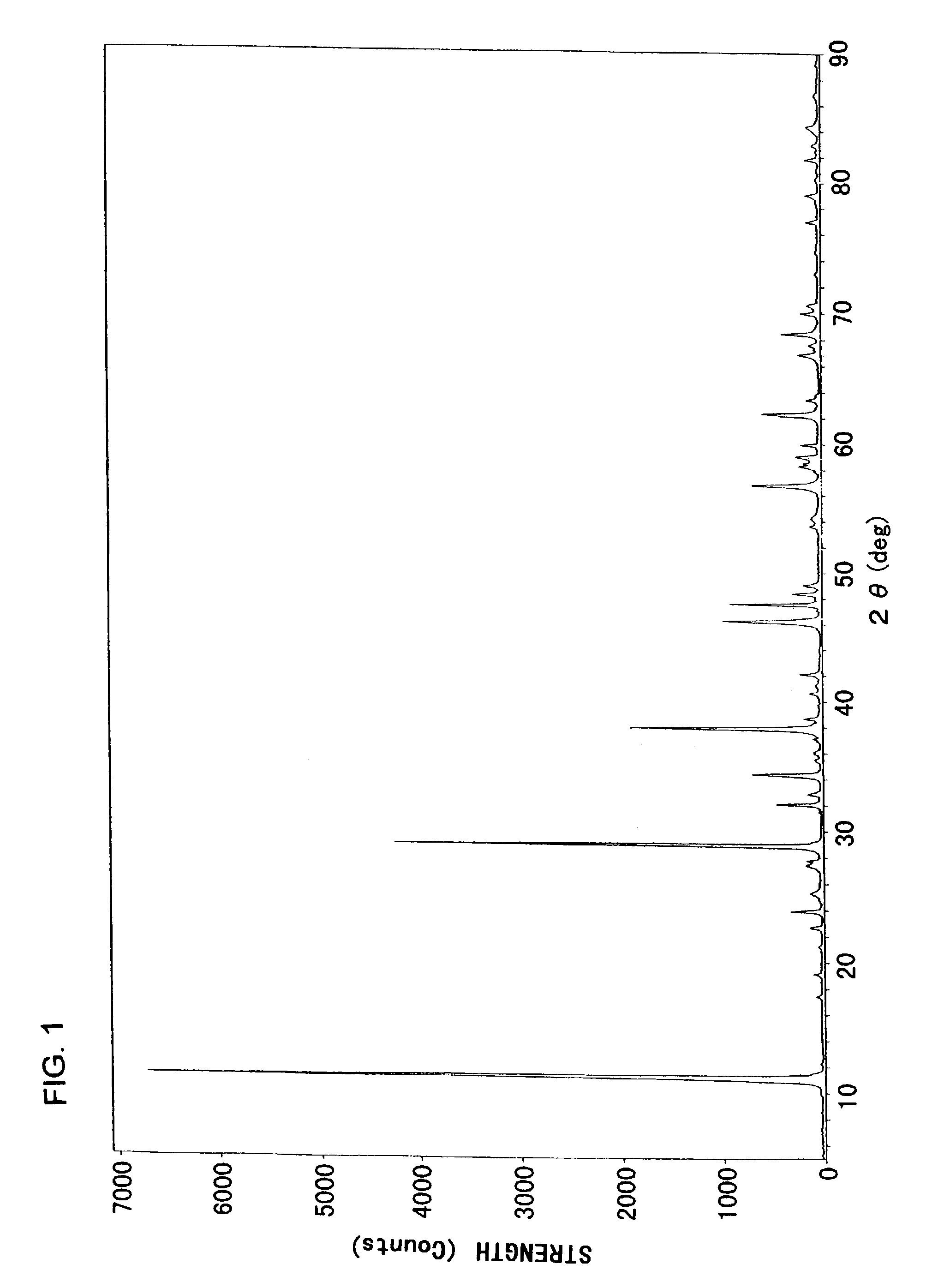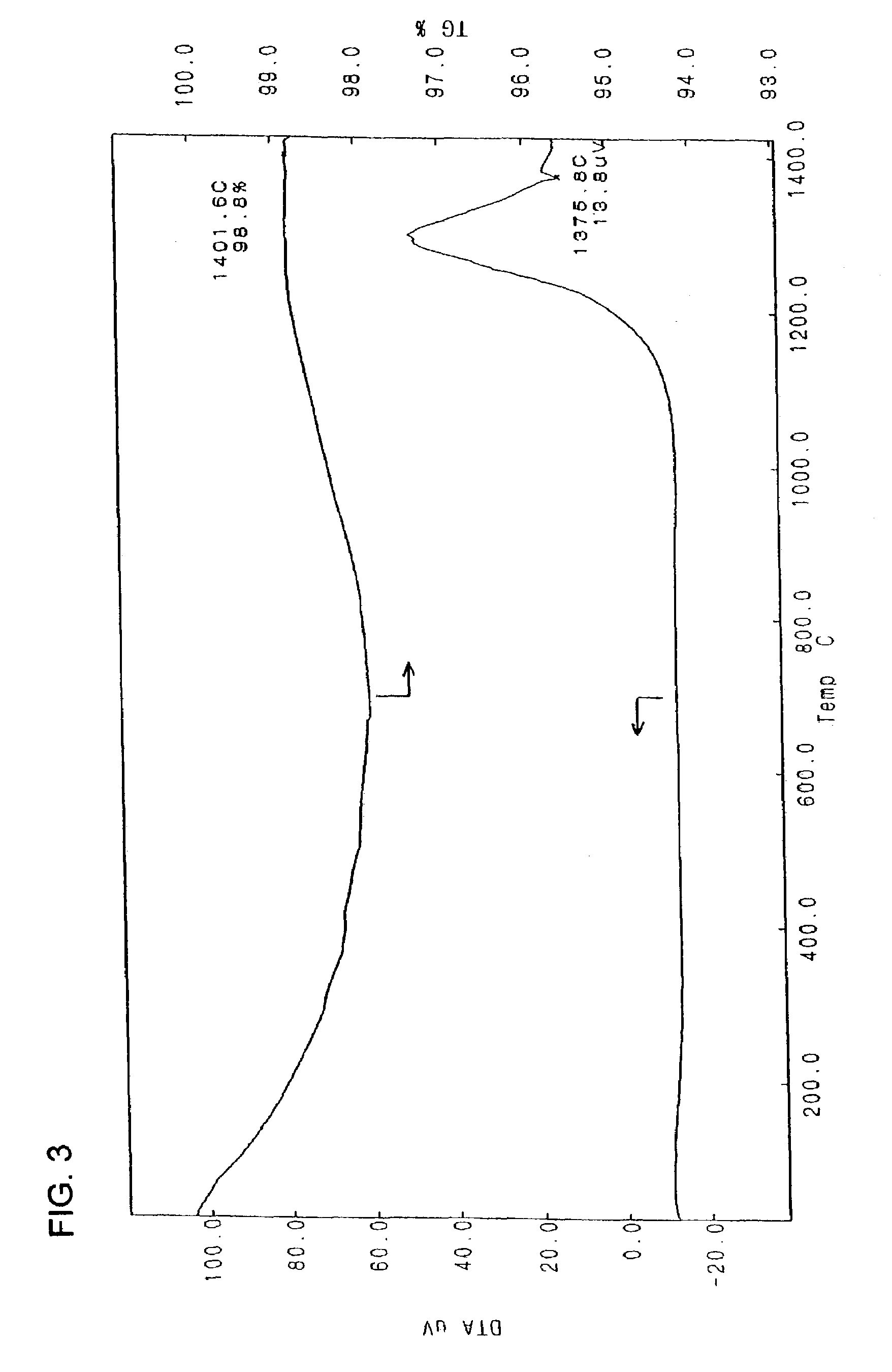Lepidocrocite potassium magnesium titanate, method for manufacturing the same and friction material
- Summary
- Abstract
- Description
- Claims
- Application Information
AI Technical Summary
Benefits of technology
Problems solved by technology
Method used
Image
Examples
example 1
[0057](1) Synthesis of KTMO-a
[0058]1473 g of titanium oxide, 638 g of potassium carbonate, 1,003 g of potassium chloride, 279 g of magnesium hydroxide and further 200 ml of water as a binder were mixed. The mixture was pressed at a pressure of 14.7 MPa into a block shape by a hydropressing machine (manufactured by Yamamoto Tekkosho, Co., Ltd.). This block was calcined at 1,050° C. for 1 hour in an electric furnace (manufactured by Advantech Toyo Co., Ltd.) and then cooled gradually. The calcined product was pulverized to obtain a white powder with an arithmetic mean of major and minor diameters of 3 μm, a mean thickness of 300 nm and a proportion of a major to minor diameter of 1.5. The white powder was identified as having a composition of K0.8Mg0.4Ti1.6O4 by fluorescent X-ray analysis using an FP (fundamental parameter) method.
[0059]FIG. 2 is an X-ray diffraction chart of the white powder obtained. The diffraction peaks were found to correspond reasonably to those given in ICDD ca...
example 2
[0066]20 parts of KTMO (K0.4Mg0.4Ti1.6O3.8) obtained in Example 1, 10 parts of aramid fibers (product name: KEVLAR PULP®, a synthetic aramid, having a mean fiber length of 3 mm), 20 parts of a phenol resin (binder) and 50 parts of barium sulfate were mixed. The mixture was preformed at a pressure of 29.4 MPa at an ambient temperature for 1 minute, integrated in a mold at a pressure of 14.7 MPa at a temperature of 170° C. for 5 minutes and heat-treated at 180° C. for subsequent 3 hours. The molded product was removed from the mold and polished to fabricate a disc pad A (JIS D 4411 test piece).
example 3
[0082]Synthesis of KTMO of the present invention:
[0083]KTMO-a obtained in (1) of Example 1 was used to prepare 80 liters of a 2% aqueous slurry to which 126 g of a 76% aqueous solution of sulfuric acid was subsequently added. The slurry was stirred for 2 hours and then adjusted to a pH of 8.5. This aqueous slurry was subjected to treatment by a centrifugal separator. The resulting cake (solids) was dispensed, dried at 110° C. for 5 hours and then calcined at 600° C. for 12 hours in an electric furnace. The calcined product was cooled gradually and then passed through a 20 mesh screen to obtain a white powder with an arithmetic mean of major and minor diameters of 3 μm, a mean thickness of 300 nm and a proportion of a major to minor diameter of 1.5. The white powder was identified as having a composition of K0.7Mg0.4Ti1.6O3.95 by fluorescent X-ray analysis using an FP method. Also, its melting point was found to be about 1,372° C.
PUM
| Property | Measurement | Unit |
|---|---|---|
| Percent by mass | aaaaa | aaaaa |
| Percent by mass | aaaaa | aaaaa |
| Percent by mass | aaaaa | aaaaa |
Abstract
Description
Claims
Application Information
 Login to View More
Login to View More - R&D
- Intellectual Property
- Life Sciences
- Materials
- Tech Scout
- Unparalleled Data Quality
- Higher Quality Content
- 60% Fewer Hallucinations
Browse by: Latest US Patents, China's latest patents, Technical Efficacy Thesaurus, Application Domain, Technology Topic, Popular Technical Reports.
© 2025 PatSnap. All rights reserved.Legal|Privacy policy|Modern Slavery Act Transparency Statement|Sitemap|About US| Contact US: help@patsnap.com



